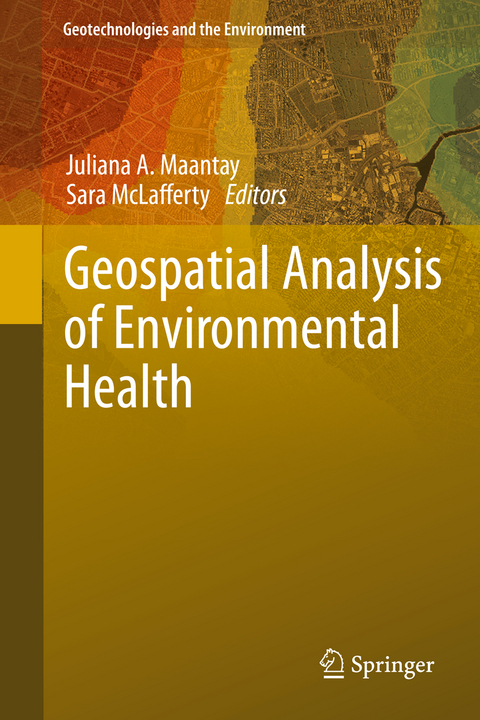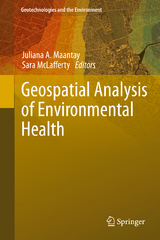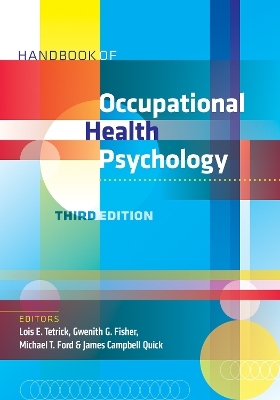Geospatial Analysis of Environmental Health
Foreword.- Section I – General Considerations in Geospatial Analysis of Environmental Health.- 1.Environmental Health and Geospatial Analysis: An Overview.- 2. Using GeoVisualization and Geospatial Analysis to Explore Respiratory Disease and Environmental Health Justice in New York City.- 3. Outdoor Air Pollution and Health – A review of the Contributions of Geotechnologies to Exposure Assessment.- 4. The Use of Residential History in Environmental Health Studies.- 5. Proximity Analysis Methods for Exposure Assessment in Environmental Health Justice Research.- Section II – Impacts on Environmental Health (Topical Case Studies).- 7. Geospatial analysis of West Nile virus (WNV) incidences in an urban environment: A Case Study in the Twin Cities Metropolitan Area of Minnesota.- 8. The Health Impacts of Brownfields in Charlotte NC: A Spatial Approach.- 9. Regional Environmental Patterns of Diarrheal Disease in Bangladesh: A Spatial Analytical and Multilevel Approach.- 10. Developing a Supermarket Need Index for New York City.- 11. Asthma, Air Quality, and Environmental Justice in Louisville, Kentucky.- 12. The Impact of Changes in Municipal Solid Waste Disposal Laws on Proximity to Environmental Hazards: A Case Study of Connecticut.- 13.Global Geographies of Environmental Injustice and Health: A Case Study of Illegal Hazardous Waste Dumping in Cote d'Ivoire.- 14. Environmental and Health Inequalities of Women in Different Neighbourhoods of Metropolitan Lagos, Nigeria.- 15. Housing Quality and Racial Disparities in Low Birth Weight: A GIS Assessment in Flint, Michigan.- Section III – Geospatial Methods in Investigating Environmental Health.- 16. Participatory mapping as a component of operational malaria vector control in Tanzania.- 17. Revisiting Tobler’s First Law of Geography: Spatial Regression Models for Assessing Environmental Justice and Health Risk Disparities.- 18. A Spatially Explicit Environmental Health Surveillance Framework for Tick-Borne Diseases.- 19. Using Distance Decay Techniques and Household-Level Data to Explore Regional Variation in Environmental Inequality.- 20. Merging Satellite Measurement with Ground-based Air Quality Monitoring Data to Assess Health Effects of Fine Particulate Matter Pollution.- 21. Poverty Determinants of Acute Respiratory Infections in the Mapuche Population of Ninth Region of Araucania, Chile (2000-2005). A Bayesian Approach with Time-space Modelling.- 22. GIS and Atmospheric Diffusion Modeling for Assessment of Individual Exposure to Dioxins Emitted from a Municipal Solid Waste Incinerator.- 23. Synthesizing waterborne infection prevalence for comparative analysis of cluster detection methods.- 24. Spatiotemporal Analysis of PM2.5 Exposure in Taipei (Taiwan) by integrating PM10 and TSP observations.- Index.
| Erscheint lt. Verlag | 23.3.2011 |
|---|---|
| Reihe/Serie | Geotechnologies and the Environment ; 4 |
| Zusatzinfo | XIV, 498 p. |
| Verlagsort | Dordrecht |
| Sprache | englisch |
| Maße | 155 x 235 mm |
| Themenwelt | Medizin / Pharmazie ► Gesundheitswesen |
| Medizin / Pharmazie ► Medizinische Fachgebiete ► Arbeits- / Sozial- / Umweltmedizin | |
| Studium ► Querschnittsbereiche ► Klinische Umweltmedizin | |
| Naturwissenschaften ► Geowissenschaften ► Geografie / Kartografie | |
| Schlagworte | Environmental Health • environmental justice • GIS • Health planning • Spatial data analysis. |
| ISBN-10 | 94-007-0328-7 / 9400703287 |
| ISBN-13 | 978-94-007-0328-5 / 9789400703285 |
| Zustand | Neuware |
| Informationen gemäß Produktsicherheitsverordnung (GPSR) | |
| Haben Sie eine Frage zum Produkt? |
aus dem Bereich



